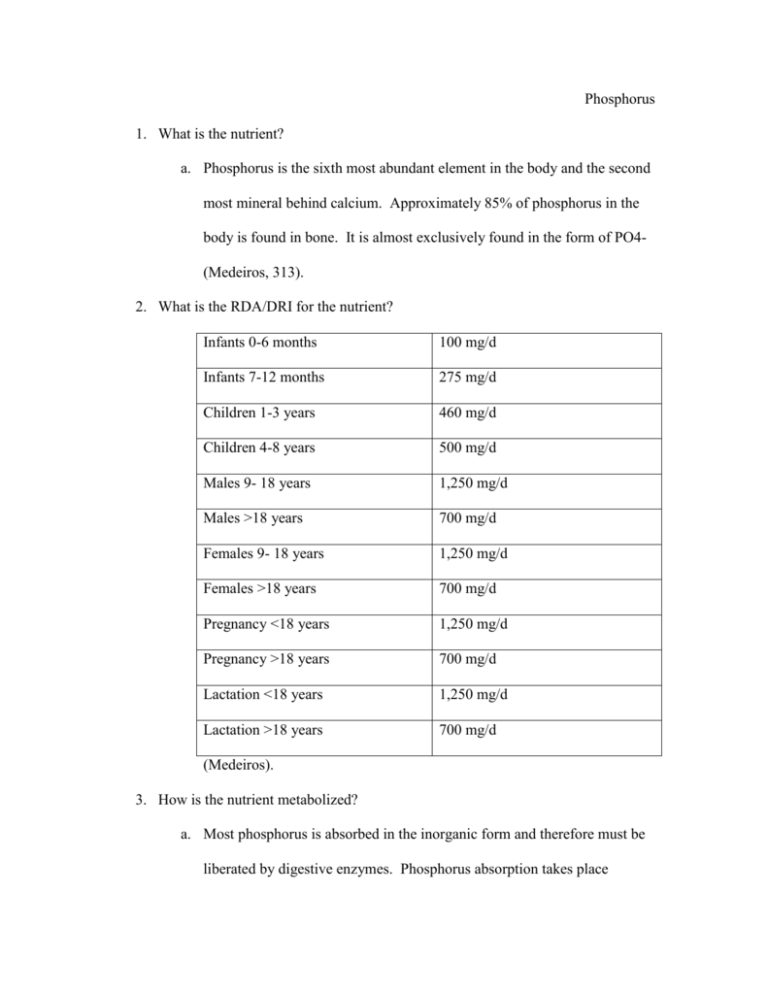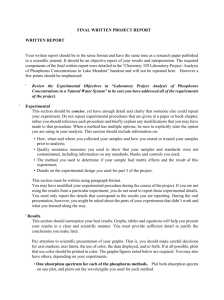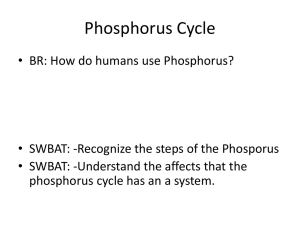File - Annelise Chmelik
advertisement

Phosphorus 1. What is the nutrient? a. Phosphorus is the sixth most abundant element in the body and the second most mineral behind calcium. Approximately 85% of phosphorus in the body is found in bone. It is almost exclusively found in the form of PO4(Medeiros, 313). 2. What is the RDA/DRI for the nutrient? Infants 0-6 months 100 mg/d Infants 7-12 months 275 mg/d Children 1-3 years 460 mg/d Children 4-8 years 500 mg/d Males 9- 18 years 1,250 mg/d Males >18 years 700 mg/d Females 9- 18 years 1,250 mg/d Females >18 years 700 mg/d Pregnancy <18 years 1,250 mg/d Pregnancy >18 years 700 mg/d Lactation <18 years 1,250 mg/d Lactation >18 years 700 mg/d (Medeiros). 3. How is the nutrient metabolized? a. Most phosphorus is absorbed in the inorganic form and therefore must be liberated by digestive enzymes. Phosphorus absorption takes place throughout the small intestine and about 50-70% is absorbed. There are two mechanisms that are involved in phosphorus absorption. The first is a carrier- mediated process and the second is a diffusion system that is linear (Medeiros, 314). 4. What are the food sources of the nutrient? a. The foods with the highest content of phosphorus are meat, poultry, eggs, fish, milk and milk products, cereals, legume, grains and chocolate. Soft drinks also contain phosphorus in the form of phosphoric acid as well as coffee and tea. Phosphorus can also be in foods in the form of phospholipids, phosphoproteins and phosphorylated sugars (Medeiros, 313). 5. What disease states alter the nutrients metabolism? a. While there are no disease states that directly decrease the absorption of phosphorus, the medications used to treat disease states such as diabetes or hypertension may cause interactions. However, individuals with an abnormally high intake of fructose in their diet may have an increased loss of phosphorus from their urine. Abnormally low intakes of calcium or Vitamin D can also cause a decrease in phosphorus absorption because their mechanisms and serum levels are interrelated (Higdon, 2003). 6. What are the tests or procedures to assess the nutrient level in the body? a. Phosphorus levels are tested through serum phosphorus levels. About 70% of the phosphorus in the blood circulates as phospholipids and the other 30% is dissolved as inorganic phosphates. The range for inorganic phosphate levels in the blood is about 2.5-4.5 mg per 100 ml. A large portion of dietary phosphorus is absorbed and as much of 2/3 of dietary phosphorus is excreted in urine (Medeiros, 314). 7. What are the drug- nutrient interactions? a. Aluminum- containing antacids reduce the absorption of phosphorus by forming aluminum phosphate, which they body cannot absorb, as well as increased urinary calcium loss. High doses of caclitrol (Vitamin D) may result in hyperphosphatremia. Taking potassium supplements in conjunction with phosphate may result in increased levels of potassium in the blood, which can create life threatening heart rhythm abnormalities (Higdon, 2003). 8. How is the nutrient measured? a. The nutrient is measured through serum phosphorus levels and the range for inorganic phosphate levels in the blood are usually 2.5-4.5 mg per 100 ml (Medeiros, 314). 9. What are the Upper Tolerable Limits? a. There is no data on Upper Tolerable limits for infants. For children ages 1-8, the Upper Tolerable limit is 3 grams per day. For males and females ages 9- 70, it is 4 grams per day but only 3 grams per day for males and females over 70. For pregnancy, the Upper Tolerable limit is 3.5 grams per day and for lactation it is 4 grams per day (Medeiros). 10. What are the physical signs of deficiency? a. Inadequate phosphorus intake can result in hypophosphatremia which can cause loss of appetite, anemia, muscle weakness, bone pain, rickets (in children), osteomalacia (in adults), increased susceptibility to infection, numbness and tingling in extremities, and difficulty walking (Higdon, 2003). If the hypophoshatremia is severe enough, it can result in death. However, because there are many sources of phosphorus in the average person’s diet, a deficiency is rarely seen in cases other than starvation (Higdon, 2003). 11. What are the physical signs of toxicity? a. The most serious effect of hyperphosphatremia is the calcification of nonskeletal tissues, usually the kidneys. This can lead to organ damage and kidney failure of hypoparathyrodism (Higdon, 2003). Resources Higdon, J. (2003, April ). Phosphorus. Retrieved from http://lpi.oregonstate.edu/infocenter/minerals/phosphorus/ Medeiros, D. (2012). Advanced human nutrition. (2nd ed.). Sudbury, MA: Jones & Bartlett Learning.






